Lexus LC Cabriolet (2021 year). Manual in english — page 1
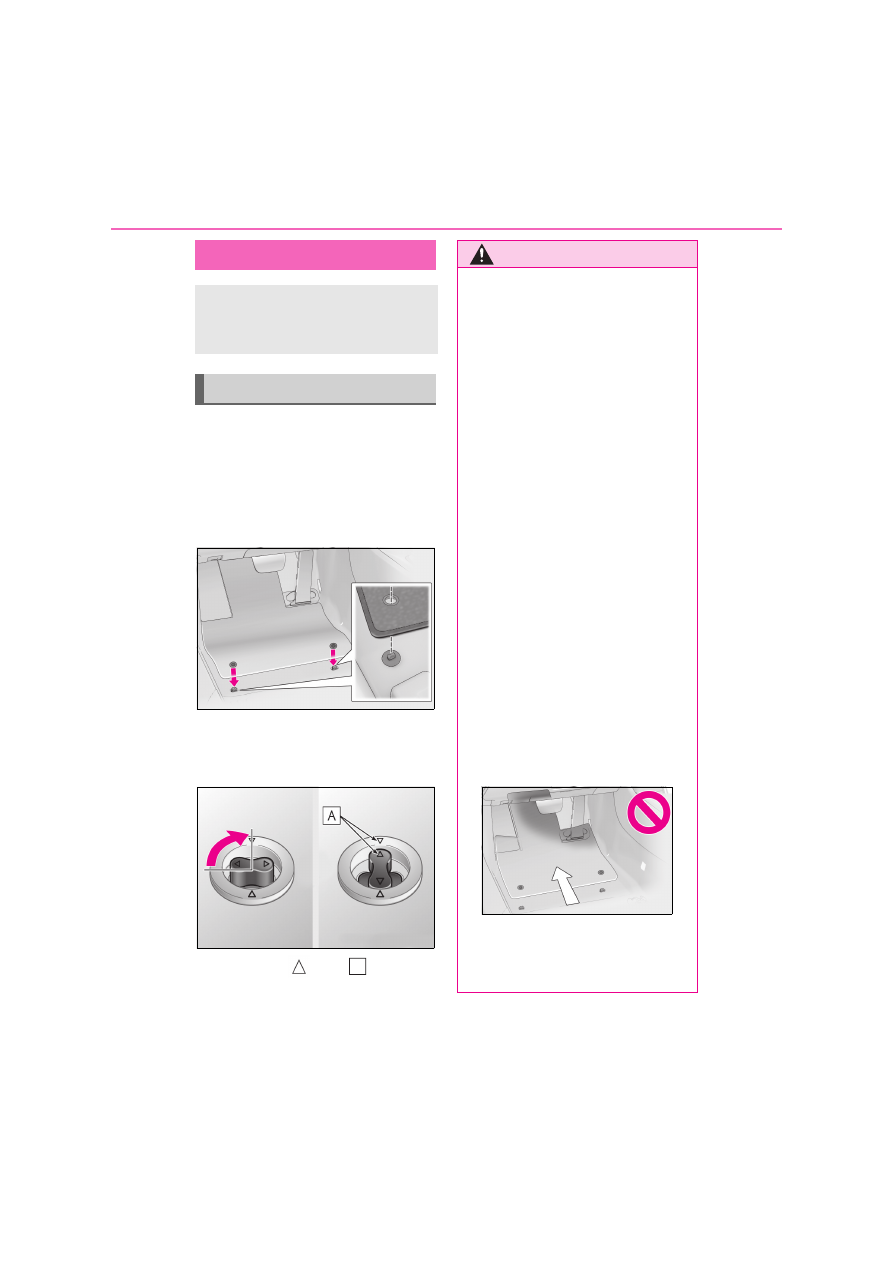
30
1-1. For safe use
1-1.For safe use
Use only floor mats designed specifi-
cally for vehicles of the same model
and model year as your vehicle. Fix
them securely in place onto the carpet.
1
Insert the retaining hooks (clips)
into the floor mat eyelets.
2
Turn the upper knob of each retain-
ing hook (clip) to secure the floor
mats in place.
Always align the
marks
.
The shape of the retaining hooks (clips)
may differ from that shown in the illustra-
tion.
Before driving
Observe the following before start-
ing off in the vehicle to ensure
safety of driving.
Installing floor mats
A
WARNING
Observe the following precautions.
Failure to do so may cause the driver’s
floor mat to slip, possibly interfering with
the pedals while driving. An unexpect-
edly high speed may result or it may
become difficult to stop the vehicle. This
could lead to an accident, resulting in
death or serious injury.
Q
When installing the driver’s floor mat
O
Do not use floor mats designed for
other models or different model year
vehicles, even if they are Lexus
Genuine floor mats.
O
Only use floor mats designed for the
driver’s seat.
O
Always install the floor mat securely
using the retaining hooks (clips) pro-
vided.
O
Do not use two or more floor mats on
top of each other.
O
Do not place the floor mat bottom-
side up or upside-down.
Q
Before driving
O
Check that the floor mat is securely
fixed in the correct place with all the
provided retaining hooks (clips). Be
especially careful to perform this
check after cleaning the floor.
O
With the engine stopped and the shift
position in P, fully depress each pedal
to the floor to make sure it does not
interfere with the floor mat.

31
1
1-1. For safe use
For
sa
fe
ty
an
d s
ec
uri
ty
Adjust the angle of the seatback so
that you are sitting straight up and
so that you do not have to lean for-
ward to steer. (
P.159)
Adjust the seat so that you can
depress the pedals fully and so that
your arms bend slightly at the
elbow when gripping the steering
wheel. (
P.159)
Lock the head restraint in place
with the center of the head restraint
closest to the top of your ears.
(
P.165)
Wear the seat belt correctly.
(
P.31)
Make sure that all occupants are wear-
ing their seat belts before driving the
vehicle. (
P.33)
Use a child restraint system appropri-
ate for the child until the child becomes
large enough to properly wear the
vehicle’s seat belt. (
P.51)
Make sure that you can see backward
clearly by adjusting the inside and out-
side rear view mirrors properly.
For safe driving
For safe driving, adjust the seat and
mirror to an appropriate position
before driving.
Correct driving posture
WARNING
Observe the following precautions.
Failure to do so may result in death or
serious injury.
A
B
C
D
O
Do not adjust the position of the
driver’s seat while driving.
Doing so could cause the driver to lose
control of the vehicle.
O
Do not place a cushion between the
driver or passenger and the seatback.
A cushion may prevent correct pos-
ture from being achieved, and reduce
the effectiveness of the seat belt and
head restraint.
O
Do not place anything under the front
seats.
Objects placed under the front seats
may become jammed in the seat
tracks and stop the seat from locking
in place. This may lead to an accident
and the adjustment mechanism may
also be damaged.
O
Always observe the legal speed limit
when driving on public roads.
O
When driving over long distances,
take regular breaks before you start to
feel tired.
Also, if you feel tired or sleepy while
driving, do not force yourself to con-
tinue driving and take a break immedi-
ately.
Correct use of the seat belts
Adjusting the mirrors
32
1-1. For safe use
(
P.167, 168)
Seat belts
Make sure that all occupants are
wearing their seat belts before driv-
ing the vehicle.
WARNING
Observe the following precautions to
reduce the risk of injury in the event of
sudden braking, sudden swerving or an
accident.
Failure to do so may cause death or seri-
ous injury.
Q
Wearing a seat belt
O
Ensure that all passengers wear a seat
belt.
O
Always wear a seat belt properly.
O
Each seat belt should be used by one
person only. Do not use a seat belt for
more than one person at once, includ-
ing children.
O
Lexus recommends that children be
seated in the rear seat and always use
a seat belt and/or an appropriate child
restraint system.
O
To achieve a proper seating position,
do not recline the seat more than nec-
essary. The seat belt is most effective
when the occupants are sitting up
straight and well back in the seats.
O
Do not wear the shoulder belt under
your arm.
O
Always wear your seat belt low and
snug across your hips.
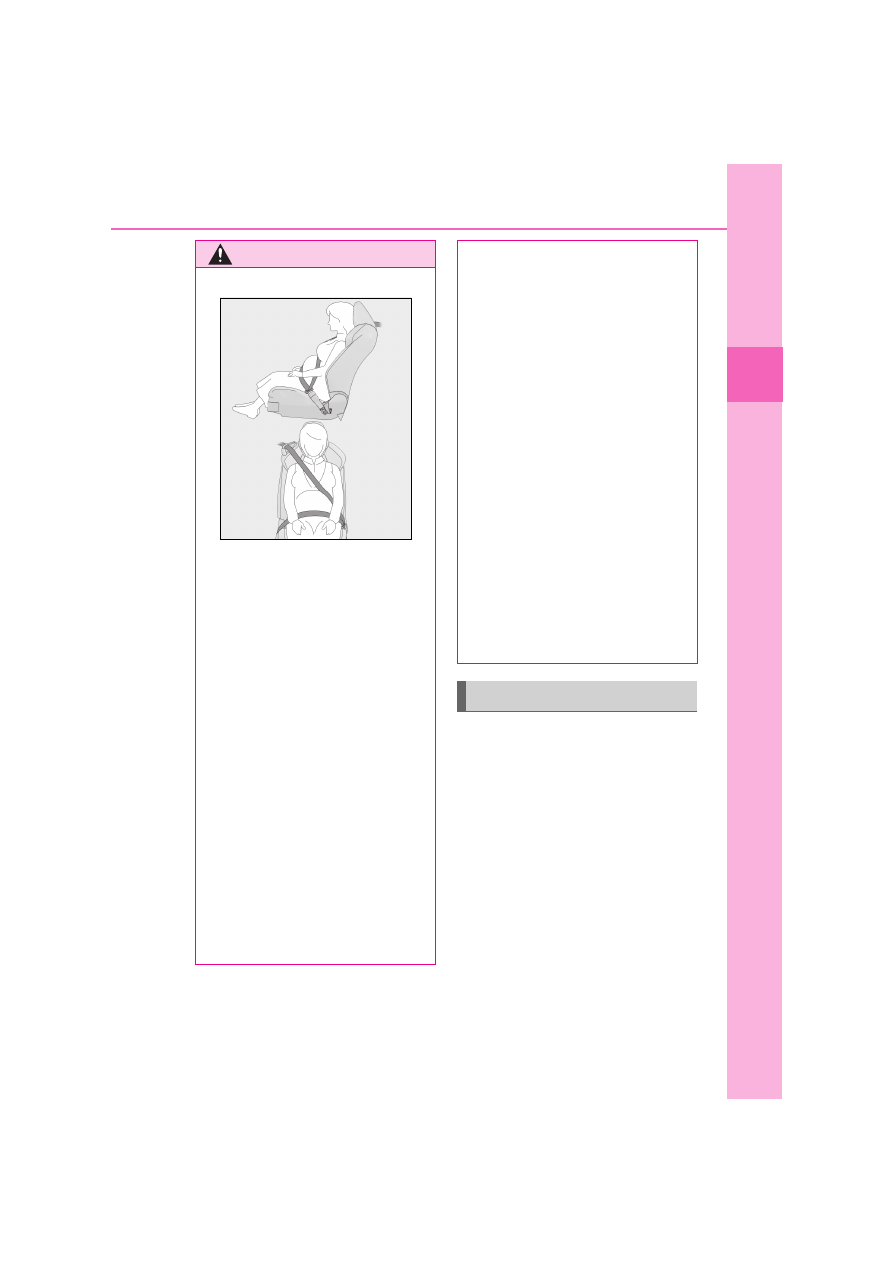
33
1
1-1. For safe use
For
sa
fe
ty
an
d s
ec
uri
ty
Extend the shoulder belt so that it
comes fully over the shoulder, but
does not come into contact with the
neck or slide off the shoulder.
Position the lap belt as low as possi-
ble over the hips.
Adjust the position of the seatback.
Sit up straight and well back in the
seat.
WARNING
Q
Pregnant women
Obtain medical advice and wear the seat
belt in the proper way. (
P.33)
Women who are pregnant should posi-
tion the lap belt as low as possible over
the hips in the same manner as other
occupants, extending the shoulder belt
completely over the shoulder and avoid-
ing belt contact with the rounding of the
abdominal area.
If the seat belt is not worn properly, not
only the pregnant woman, but also the
fetus could suffer death or serious injury
as a result of sudden braking or a colli-
sion.
Q
People suffering illness
Obtain medical advice and wear the seat
belt in the proper way. (
P.33)
Q
When children are in the vehicle
P.50
Q
Seat belt damage and wear
O
Do not damage the seat belts by allow-
ing the belt, plate, or buckle to be
jammed in the door.
O
Inspect the seat belt system periodi-
cally. Check for cuts, fraying, and
loose parts. Do not use a damaged
seat belt until it is replaced. Damaged
seat belts cannot protect an occupant
from death or serious injury.
O
Ensure that the belt and plate are
locked and the belt is not twisted.
If the seat belt does not function cor-
rectly, immediately contact any autho-
rized Lexus retailer or Lexus
authorized repairer, or any reliable
repairer.
O
Replace the seat assembly, including
the belts, if your vehicle has been
involved in a serious accident, even if
there is no obvious damage.
O
Do not attempt to install, remove,
modify, disassemble or dispose of the
seat belts. Have any necessary repairs
carried out by any authorized Lexus
retailer or Lexus authorized repairer,
or any reliable repairer. Inappropriate
handling may lead to incorrect opera-
tion.
Correct use of the seat belts
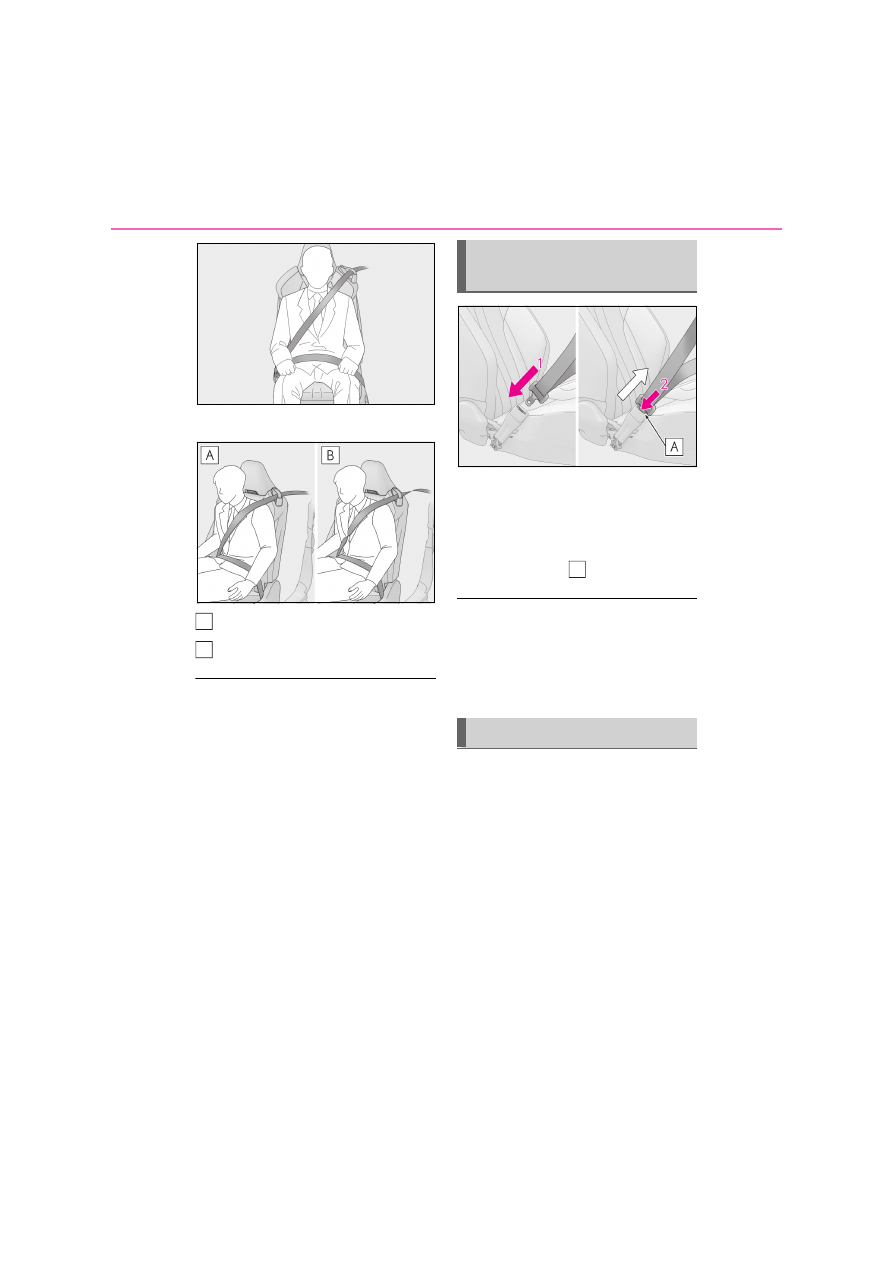
34
1-1. For safe use
Do not twist the seat belt.
Not twisted
Twisted
Q
Child seat belt usage
The seat belts of your vehicle were princi-
pally designed for persons of adult size.
O
Use a child restraint system appropriate
for the child, until the child becomes large
enough to properly wear the vehicle’s
seat belt. (
P.51)
O
When the child becomes large enough to
properly wear the vehicle’s seat belt, fol-
low the instructions regarding seat belt
usage.
Q
Seat belt regulations
If seat belt regulations exist in the country
where you reside, please contact any
authorized Lexus retailer or Lexus autho-
rized repairer, or any reliable repairer for
seat belt replacement or installation.
1
To fasten the seat belt, push the
plate into the buckle until a click
sound is heard.
2
To release the seat belt, press the
release button
.
Q
Emergency locking retractor (ELR)
The retractor will lock the belt during a sud-
den stop or on impact. It may also lock if you
lean forward too quickly. A slow, easy
motion will allow the belt to extend so that
you can move around fully.
The front seats are equipped with
guides to pass the seat belt. When
using the seat belt, make sure to pass
the seat belt through the guide.
When getting into or out of a rear seat,
release the seat belt from the guide.
A
B
Fastening and releasing the seat
belt
Seat belt guide
A
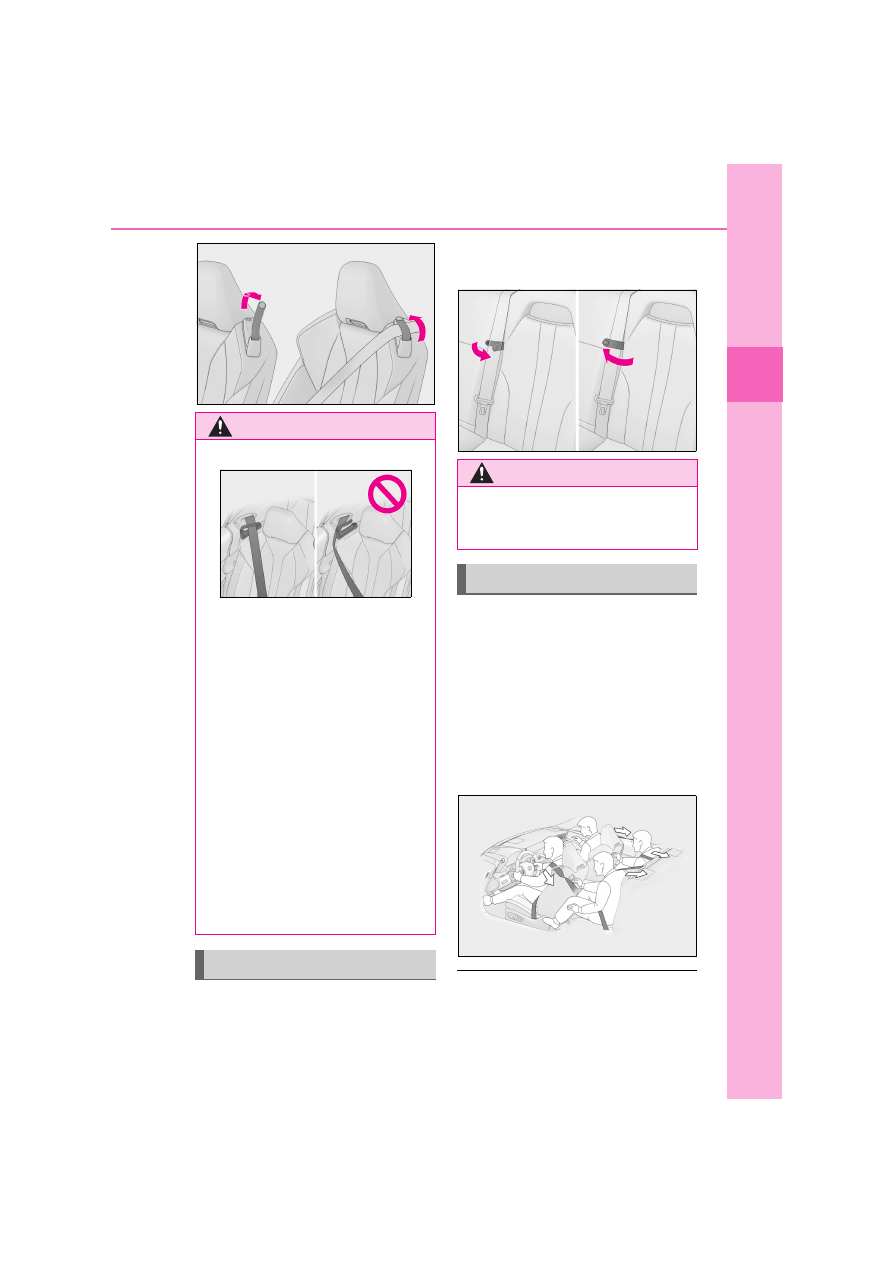
35
1
1-1. For safe use
For
sa
fe
ty
an
d s
ec
uri
ty
The rear seats are equipped with belt
holders to secure the seat belt. When
the seat belt flaps in the wind, secure
the seat belt using the belt holder.
The pretensioners help the seat belts to
quickly restrain the occupants by
retracting the seat belts when the vehi-
cle is subjected to certain types of
severe frontal or side collision or a
vehicle rollover.
The pretensioners do not activate in the
event of a minor frontal impact, a minor
side impact or a rear impact.
Q
Replacing the belt after the preten-
sioner has been activated
If the vehicle is involved in multiple colli-
WARNING
Q
Seat belt guide
Make sure to pass the seat belt through
the seat belt guide when using the seat
belt.
Q
When using the seat belt guide
Observe the following precautions to
reduce the risk of injury in the event of
sudden braking, sudden swerving or an
accident.
Failure to do so may cause death or seri-
ous injury.
O
Always make sure that the belt is not
twisted, and runs freely through the
guide.
O
Regardless of whether the guide is
used or not, always secure the seat
belt guide button.
O
Do not hang from or pull the guide
forcefully.
Rear seat belt holder
WARNING
Q
When using the rear seat belt
Make sure to release the seat belt from
the belt holder.
Seat belt pretensioners
36
1-1. For safe use
sions, the pretensioner will activate for the
first collision, but will not activate for the
second or subsequent collisions.
WARNING
Q
Seat belt pretensioners
If the pretensioner has activated, the SRS
warning light will come on. In that case,
the seat belt cannot be used again and
must be replaced at any authorized
Lexus retailer or Lexus authorized
repairer, or any reliable repairer.
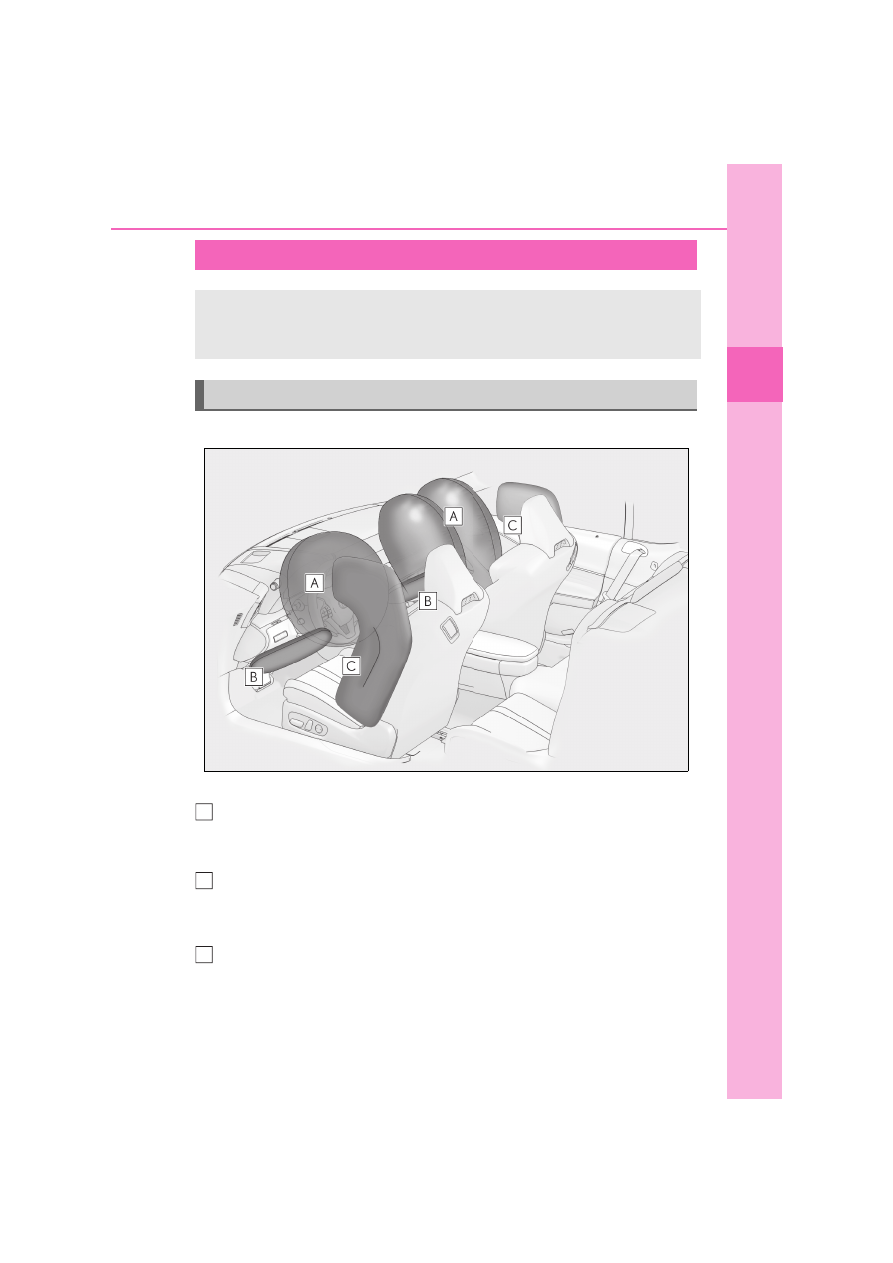
37
1
1-1. For safe use
For
sa
fe
ty
an
d s
ec
uri
ty
Q
Location of the SRS airbags
SRS front airbags
SRS driver airbag/front passenger airbag
Can help protect the head and chest of the driver and front passenger from
impact with interior components
SRS knee airbags
Can help provide driver and front passenger protection
SRS side airbags
SRS side airbags
Can help protect the torso of the front seat occupants
SRS airbags
The SRS airbags inflate when the vehicle is subjected to certain types of
severe impacts that may cause significant injury to the occupants. They work
together with the seat belts to help reduce the risk of death or serious injury.
SRS airbag system
A
B
C

38
1-1. For safe use
Q
SRS airbag system components
Airbag manual on-off switch
Front passenger airbag
Knee airbags
“PASSENGER AIR BAG” indicator lights
Seat belt pretensioners and force limiters
Side impact sensors (front)
Front side airbags
SRS warning light
Driver airbag
Driver’s seat position sensor
Driver’s seat belt buckle switch
Airbag sensor assembly
Front passenger’s seat belt buckle switch
Front impact sensors
Side impact sensors (door)
A
B
C
D
E
F
G
H
I
J
K
L
M
N
O
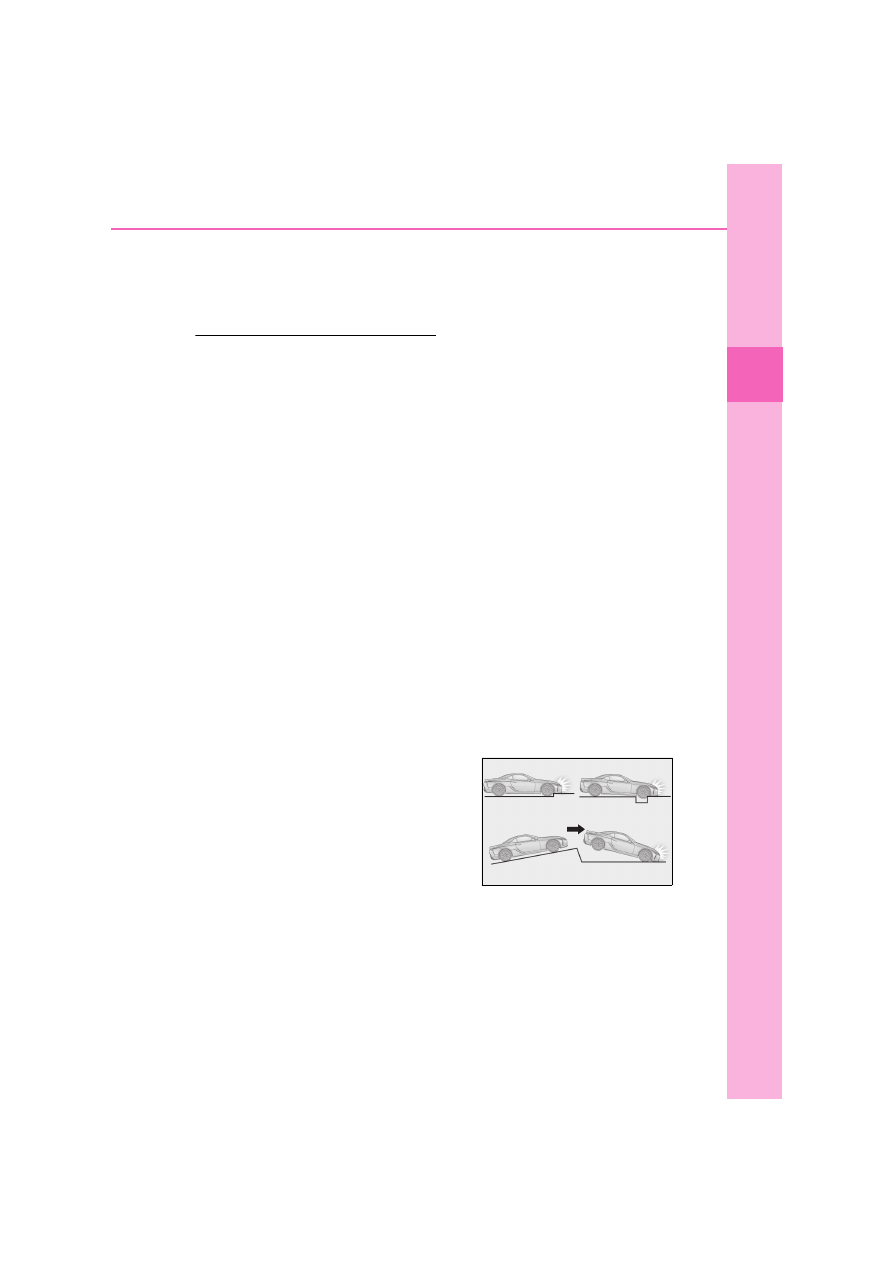
39
1
1-1. For safe use
For
sa
fe
ty
an
d s
ec
uri
ty
The main SRS airbag system components are shown above. The SRS airbag sys-
tem is controlled by the airbag sensor assembly. As the airbags deploy, a chemical
reaction in the inflators quickly fills the airbags with non-toxic gas to help restrain
the motion of the occupants.
Q
If the SRS airbags deploy (inflate)
O
Slight abrasions, burns, bruising etc., may
be sustained from SRS airbags, due to the
extremely high speed deployment (infla-
tion) by hot gases.
O
A loud noise and white powder will be
emitted.
O
Parts of the airbag module (steering
wheel hub, airbag cover and inflator) as
well as the front seats may be hot for sev-
eral minutes. The airbag itself may also be
hot.
O
The windshield may crack.
O
All of the doors will be unlocked.
(
P.113)
O
The brakes and stop lights will be con-
trolled automatically. (
P.291)
O
The interior lights will turn on automati-
cally. (
P.319)
O
The emergency flashers will turn on auto-
matically. (
P.380)
O
Fuel supply to the engine will be stopped.
(
P.387)
Q
SRS airbag deployment conditions (SRS
front airbags)
O
The SRS front airbags will deploy in the
event of an impact that exceeds the set
threshold level (the level of force corre-
sponding to an approximately 20 - 30
km/h [12 - 18 mph] frontal collision with a
fixed wall that does not move or deform).
However, this threshold velocity will be
considerably higher in the following situ-
ations:
• If the vehicle strikes an object, such as a
parked vehicle or sign pole, which can
move or deform on impact
• If the vehicle is involved in an underride
collision, such as a collision in which the
front of the vehicle “underrides”, or goes
under, the bed of a truck
O
Depending on the type of collision, it is
possible that only the seat belt preten-
sioners will activate.
Q
SRS airbag deployment conditions (SRS
side airbags)
The SRS side airbags will deploy in the
event of an impact that exceeds the set
threshold level (the level of force corre-
sponding to the impact force produced by
an approximately 1500 kg [3300 lb.] vehi-
cle colliding with the vehicle cabin from a
direction perpendicular to the vehicle ori-
entation at an approximate speed of 20 -
30 km/h [12 - 18 mph]).
Q
Conditions under which the SRS air-
bags may deploy (inflate), other than a
collision
The SRS front airbags may also deploy if a
serious impact occurs to the underside of
your vehicle. Some examples are shown in
the illustration.
O
Hitting a curb, edge of pavement or hard
surface
O
Falling into or jumping over a deep hole
O
Landing hard or falling
Q
Types of collisions that may not deploy
the SRS airbags (SRS front airbags)
The SRS front airbags do not generally
inflate if the vehicle is involved in a side or
rear collision, if it rolls over, or if it is involved
in a low-speed frontal collision. But, when-
ever a collision of any type causes sufficient
forward deceleration of the vehicle, deploy-
ment of the SRS front airbags may occur.
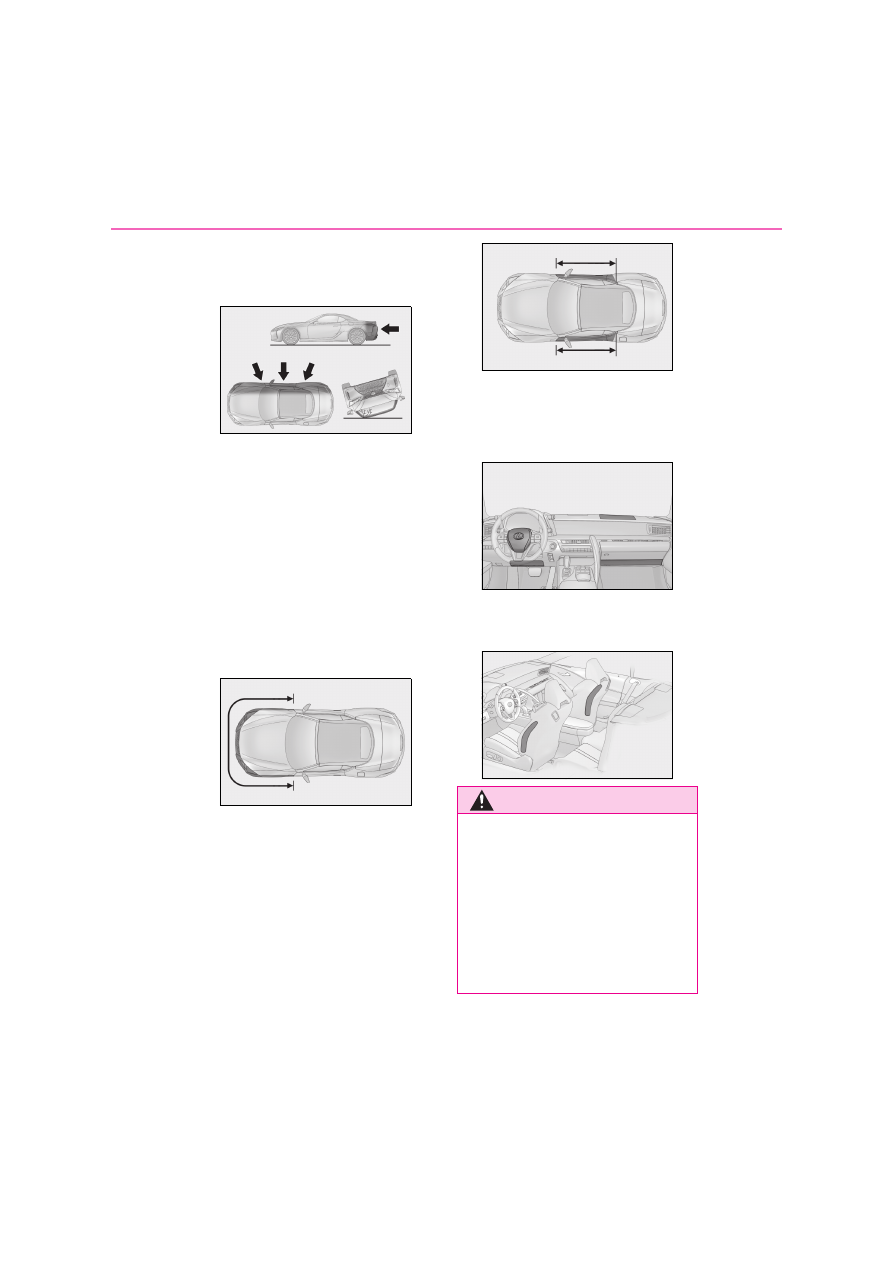
40
1-1. For safe use
O
Collision from the side
O
Collision from the rear
O
Vehicle rollover
Q
When to contact any authorized Lexus
retailer or Lexus authorized repairer, or
any reliable repairer
In the following cases, the vehicle will
require inspection and/or repair. Contact
any authorized Lexus retailer or Lexus
authorized repairer, or any reliable repairer
as soon as possible.
O
Any of the SRS airbags have been
inflated.
O
The front of the vehicle is damaged or
deformed, or was involved in an accident
that was not severe enough to cause the
SRS front airbags to inflate.
O
A portion of a door or its surrounding
area is damaged, deformed or has had a
hole made in it, or the vehicle was
involved in an accident that was not
severe enough to cause the SRS side air-
bags to inflate.
O
The pad section of the steering wheel,
dashboard near the front passenger air-
bag or lower portion of the instrument
panel is scratched, cracked, or otherwise
damaged.
O
The surface of the seats with the SRS side
airbag is scratched, cracked, or other-
wise damaged.
WARNING
Q
SRS airbag precautions
Observe the following precautions
regarding the SRS airbags.
Failure to do so may cause death or seri-
ous injury.
O
The driver and all passengers in the
vehicle must wear their seat belts
properly.
The SRS airbags are supplemental
devices to be used with the seat belts.
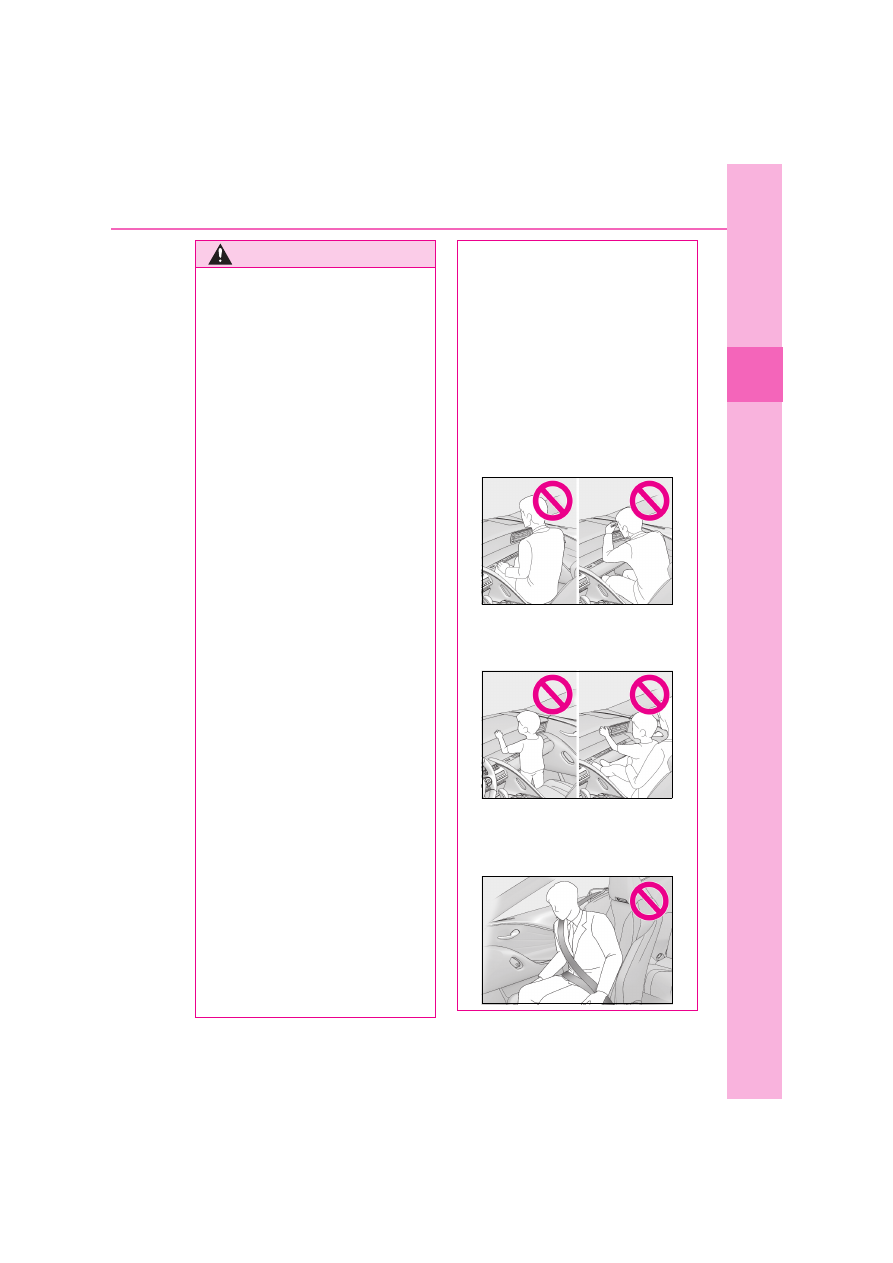
41
1
1-1. For safe use
For
sa
fe
ty
an
d s
ec
uri
ty
WARNING
O
The SRS driver airbag deploys with
considerable force, and can cause
death or serious injury especially if the
driver is very close to the airbag.
Since the risk zone for the driver’s air-
bag is the first 50 - 75 mm (2 - 3 in.) of
inflation, placing yourself 250 mm (10
in.) from your driver airbag provides
you with a clear margin of safety. This
distance is measured from the center
of the steering wheel to your breast-
bone. If you sit less than 250 mm (10
in.) away now, you can change your
driving position in several ways:
• Move your seat to the rear as far as
you can while still reaching the pedals
comfortably.
• Slightly recline the back of the seat.
Although vehicle designs vary, many
drivers can achieve the 250 mm (10
in.) distance, even with the driver seat
all the way forward, simply by reclining
the back of the seat somewhat. If
reclining the back of your seat makes it
hard to see the road, raise yourself by
using a firm, non-slippery cushion, or
raise the seat if your vehicle has that
feature.
• If your steering wheel is adjustable, tilt
it downward. This points the airbag
toward your chest instead of your
head and neck.
The seat should be adjusted as recom-
mended above, while still maintaining
control of the foot pedals, steering wheel,
and your view of the instrument panel
controls.
O
The SRS front passenger airbag also
deploys with considerable force, and
can cause death or serious injury
especially if the front passenger is very
close to the airbag. The front passen-
ger seat should be as far from the air-
bag as possible with the seatback
adjusted, so the front passenger sits
upright.
O
Improperly seated and/or restrained
infants and children can be killed or
seriously injured by a deploying air-
bag. An infant or child who is too small
to use a seat belt should be properly
secured using a child restraint system.
Lexus strongly recommends that all
infants and children be placed in the
rear seats of the vehicle and properly
restrained. The rear seats are safer for
infants and children than the front pas-
senger seat. (
P.51)
O
Do not sit on the edge of the seat or
lean against the dashboard.
O
Do not allow a child to stand in front of
the SRS front passenger airbag unit or
sit on the knees of a front passenger.
O
Do not allow the front seat occupants
to hold items on their knees.
O
Do not lean against the front door.

42
1-1. For safe use
WARNING
O
Do not allow anyone to kneel on the
passenger seat toward the door or put
their head or hands outside the vehi-
cle.
O
Do not attach anything to or lean any-
thing against areas such as the dash-
board, steering wheel pad and lower
portion of the instrument panel.
These items can become projectiles
when the SRS driver, front passenger
and knee airbags deploy.
O
Do not attach anything to areas such
as a door, windshield glass and side
door glass.
O
If a vinyl cover is put on the area where
the SRS knee airbag will deploy, be
sure to remove it.
O
Do not use seat accessories which
cover the parts where the SRS side air-
bags inflate as they may interfere with
inflation of the SRS airbags. Such
accessories may prevent the side air-
bags from activating correctly, disable
the system or cause the side airbags to
inflate accidentally, resulting in death
or serious injury.
O
Do not strike or apply significant levels
of force to the area of the SRS airbag
components or the doors.
Doing so can cause the SRS airbags to
malfunction.
O
Do not touch any of the component
parts immediately after the SRS air-
bags have deployed (inflated) as they
may be hot.
O
If breathing becomes difficult after the
SRS airbags have deployed, open a
door or window to allow fresh air in, or
leave the vehicle if it is safe to do so.
Wash off any residue as soon as possi-
ble to prevent skin irritation.
O
If the areas where the SRS airbags are
stored, such as the steering wheel pad,
are damaged or cracked, have them
replaced by any authorized Lexus
retailer or Lexus authorized repairer,
or any reliable repairer.
Q
Modification and disposal of SRS air-
bag system components
Do not dispose of your vehicle or per-
form any of the following modifications
without consulting any authorized Lexus
retailer or Lexus authorized repairer, or
any reliable repairer. The SRS airbags
may malfunction or deploy (inflate) acci-
dentally, causing death or serious injury.
O
Installation, removal, disassembly and
repair of the SRS airbags
O
Repairs, modifications, removal or
replacement of the steering wheel,
instrument panel, dashboard, seats or
seat upholstery, door panels, door
trims or door speakers
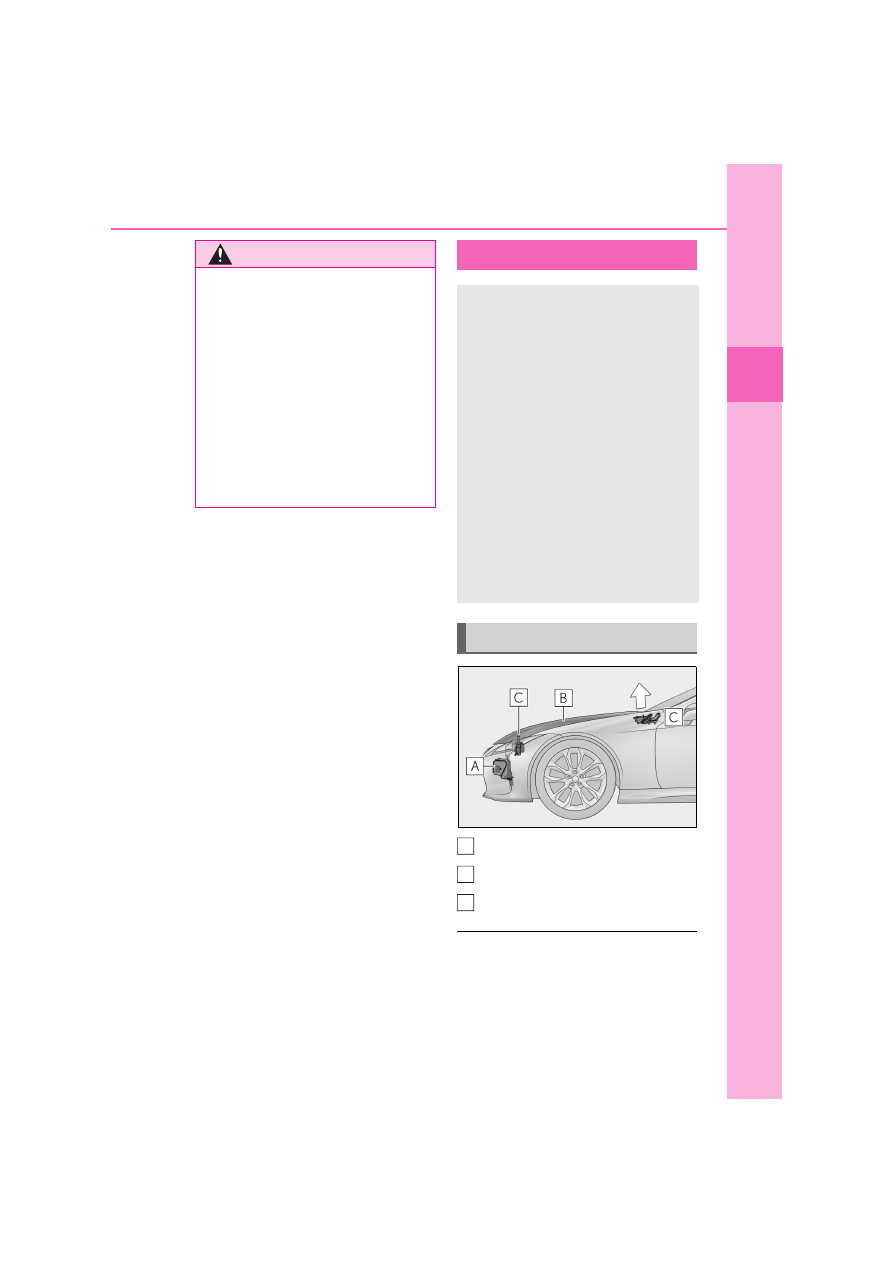
43
1
1-1. For safe use
For
sa
fe
ty
an
d s
ec
uri
ty
Sensors
Hood
Lifters
Q
Pop Up Hood precautions
O
Before scrapping your vehicle, make
sure to contact any authorized Lexus
retailer or Lexus authorized repairer, or
any reliable repairer.
WARNING
O
Modifications to the door panel (such
as making a hole in it)
O
Repairs or modifications of the front
fender, or front bumper
O
Installation of a grille guard (bull bars,
kangaroo bar, etc.), snow plows,
winches or roof luggage carrier
O
Modifications to the vehicle’s suspen-
sion system
O
Installation of electronic devices such
as mobile two-way radios (RF-trans-
mitter) and CD players
Pop Up Hood
In the event of a frontal collision
with a body, such as a pedestrian,
the Pop Up Hood system raises the
hood to reduce the possibility of a
serious impact to the pedestrian’s
head area by adding clearance to
the engine compartment.
When the sensors located at the
back of the front bumper detect a
frontal impact with a body, such as a
pedestrian, which meets or
exceeds the threshold level while
the vehicle is being driven within
the operational speed range, the
system operates.
System components
A
B
C
44
1-1. For safe use
O
The Pop Up Hood system cannot be
reused once it has operated. Have it
replaced by any authorized Lexus
retailer or Lexus authorized repairer, or
any reliable repairer.
Q
Pop Up Hood operational conditions
The Pop Up Hood will operate when the
vehicle detects an impact such as the fol-
lowing:
O
The front bumper detects a frontal
impact equivalent to or greater than that
of a pedestrian while the vehicle being
driven within the operational speed
range of approximately 25 to 55 km/h
(16 to 34 mph). (The system is operated
by an impact of threshold level or greater,
even in the case of a minor collision that
may not leave a trace on the front
bumper. Also, depending on the impact
conditions or vehicle speed, the system
may operate by a collision with a light or
small object or a small animal.)
O
In other situations such as the following,
the system may operate when an impact
is applied to the lower part of the vehicle
or front bumper:
• Colliding with a curb
• Falling into a deep hole
• Landing hard
• Hitting the slope of a parking lot, an
undulating road, a protruding object or
falling object
Q
Conditions under which the Pop Up
Hood may not operate properly
O
If a pedestrian collides with the right or
left corner of the front bumper or the side
of the vehicle. As such impacts may be
difficult to detect, the system may not
operate.
O
If the vehicle speed is not detected cor-
rectly, such as if the vehicle is sliding side-
ways, the system may not operate
properly.
Q
Conditions under which the Pop Up
Hood will not operate
The Pop Up Hood will not operate in the
following situations:
O
Colliding with a lying person
O
A frontal impact applied to the front
bumper while driving at speeds outside
of the operational speed range
O
A side impact or rear impact
O
A vehicle rollover (In some accident situ-
ations, the Pop Up Hood may operate.)
WARNING
Q
When the Pop Up Hood is operated
O
Do not pull the hood lock release
lever. Doing so after the Pop Up Hood
has operated will further raise the
hood and may cause an injury. Do not
drive with the hood raised, as doing so
may block the driver’s vision, possibly
causing an accident.
O
Do not forcibly push down the hood.
As the popped up hood cannot be
lowered by hand, doing so may
deform the hood or cause an injury.
O
If the Pop Up Hood has operated,
have it replaced by any authorized
Lexus retailer or Lexus authorized
repairer, or any reliable repairer. If the
Pop Up Hood has operated, stop the
vehicle in a safe place and contact
authorized Lexus retailer or Lexus
authorized repairer, or any reliable
repairer.
O
Do not touch the lifters immediately
after the Pop Up Hood has operated,
as the lifters may be hot and burn you.
NOTICE
Q
Pop Up Hood precautions
O
Make sure to close the hood before
driving, as the system may not operate
properly if the hood is not fully closed.
O
Make sure that all 4 tires are of the
specified size and inflated to the speci-
fied tire pressure. If tires of a different
size are used, the system may not
operate properly.
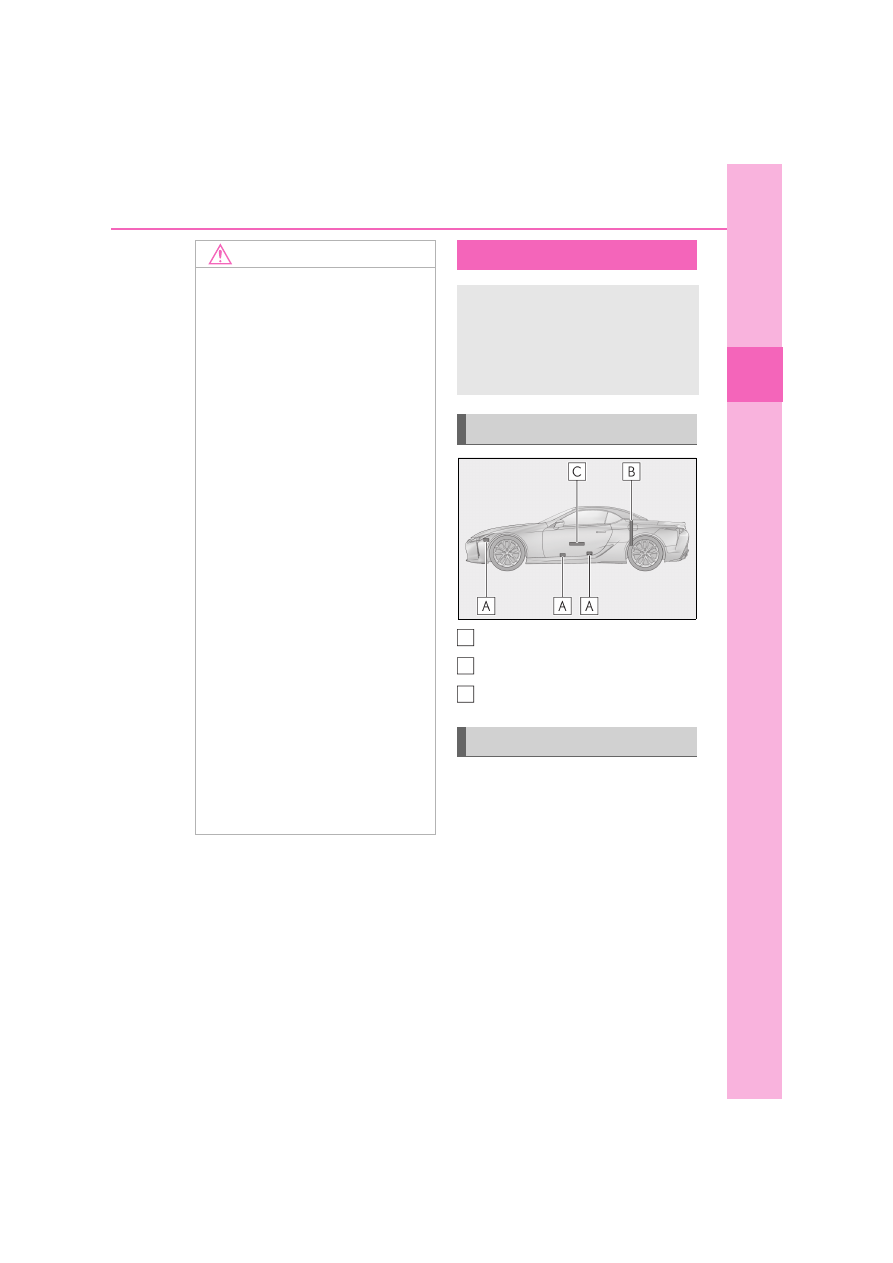
45
1
1-1. For safe use
For
sa
fe
ty
an
d s
ec
uri
ty
Sensors
Active roll bar
ECU
The active roll bar is stored behind the
rear seats. When the system operates,
the bars pop out upward.
NOTICE
O
If something has hit the area around
the front bumper, the sensors may be
damaged even if the Pop Up Hood has
not operated. Have the vehicle
inspected by any authorized Lexus
retailer or Lexus authorized repairer,
or any reliable repairer.
O
Do not remove or repair the parts or
wiring of the Pop Up Hood, as doing
so may cause accidental operation or
prevent the system from operating
properly. If repair or replacement is
necessary, contact any authorized
Lexus retailer or Lexus authorized
repairer, or any reliable repairer.
O
Do not remove such components as
the front bumper, hood or suspension,
or replace them with non-genuine
parts, as doing so may prevent the sys-
tem from operating properly.
O
Do not install anything to the front
bumper or hood, as doing so may pre-
vent the sensors from detecting an
impact correctly and prevent the sys-
tem from operating properly.
O
Do not close the hood with force or
apply load to the lifters, as doing so
may damage the lifters and prevent
the system from operating properly.
O
Do not modify the suspension, as
changes made to the vehicle height
may prevent the system from operat-
ing properly.
Active roll bar
The active roll bar is the mechanism
that ensure the bars to pop out
upward when the sensors detect a
frontal or side impact, or vehicle
rollover.
System components
Operation of the active roll bar
A
B
C

Нет комментариевНе стесняйтесь поделиться с нами вашим ценным мнением.
Текст